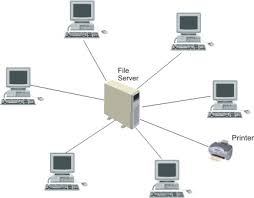



Alternatively referred to as a ring network, a ring topologyis a computer network configuration where the devices are connected to each other in a circular shape. Each packet is sent around the ring until it reaches its final destination. Ring topologies are used in both local area network (LAN) and wide area network (WAN) setups. The picture to the right is a visual example of a network using the ring topology to connect several computers together.
Additional information
In the past, the ring topology was most commonly used in schools, offices, and smaller buildings where networks were smaller. However, today, the ring topology is seldom used, having been switched to another type of network topology for improved performance, stability, or support.
Advantages of ring topology
- All data flows in one direction, reducing the chance of packet collisions.
- A network server is not needed to control network connectivity between each workstation.
- Data can transfer between workstations at high speeds.
- Additional workstations can be added without impacting performance of the network.
Disadvantages of ring topology
- All data being transferred over the network must pass through each workstation on the network, which can make it slower than a star topology.
- The entire network will be impacted if one workstation shuts down.
- The hardware needed to connect each workstation to the network is more expensive than Ethernet cards and hubs/switches.
Alternatively referred to as a star network, star topology is one of the most common network setups. In this configuration, every node connects to a central network device, like a hub, switch, or computer. The central network device acts as a server and the peripheral devices act as clients.
The picture to the right shows how this network setup gets its name, as it is shaped like a star.
Advantages of star topology
- Centralized management of the network, through the use of the central computer, hub, or switch.
- Easy to add another computer to the network.
- If one computer on the network fails, the rest of the network continues to function normally.
Disadvantages of star topology
- Can have a higher cost to implement, especially when using a switch or router as the central network device.
- The central network device determines the performance and number of nodes the network can handle.
- If the central computer, hub, or switch fails, the entire network goes down and all computers are disconnected from the network
Alternatively referred to as a line topology, a bus topology is a network setup in which each computer and network device are connected to a single cable or backbone. The following sections contain both the advantages and disadvantages of using a bus topology with your devices.
Advantages of bus topology
- It works well when you have a small network.
- Easiest network topology for connecting computers or peripherals in a linear fashion.
- Requires less cable length than a star topology.
Disadvantages of bus topology
- Difficult to identify the problems if the whole network goes down.
- It can be hard to troubleshoot individual device issues.
- Not great for large networks.
- Terminators are required for both ends of the main cable.
- Additional devices slow the network down.
- If a main cable is damaged, the network fails or splits into two
